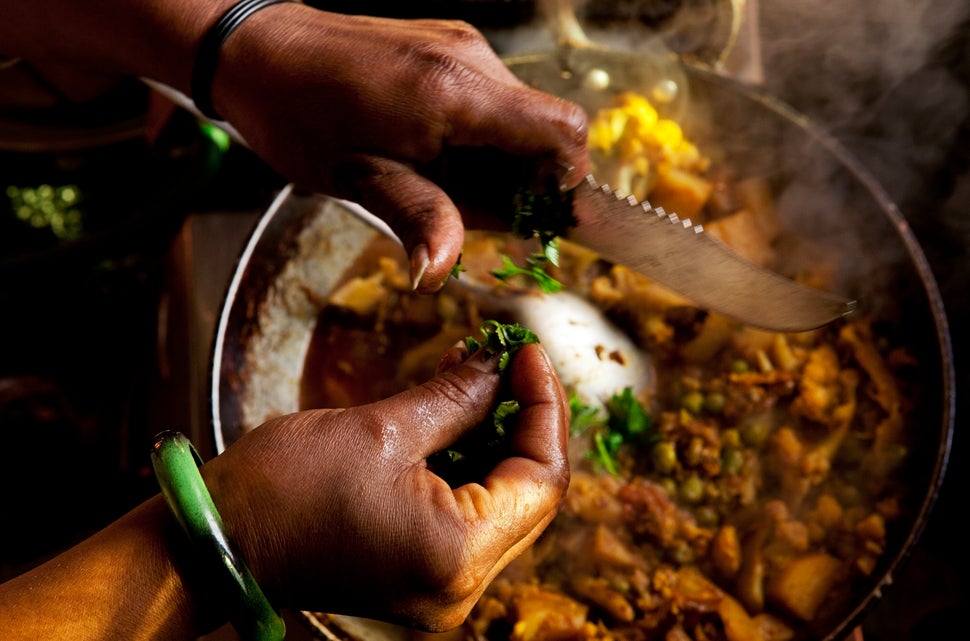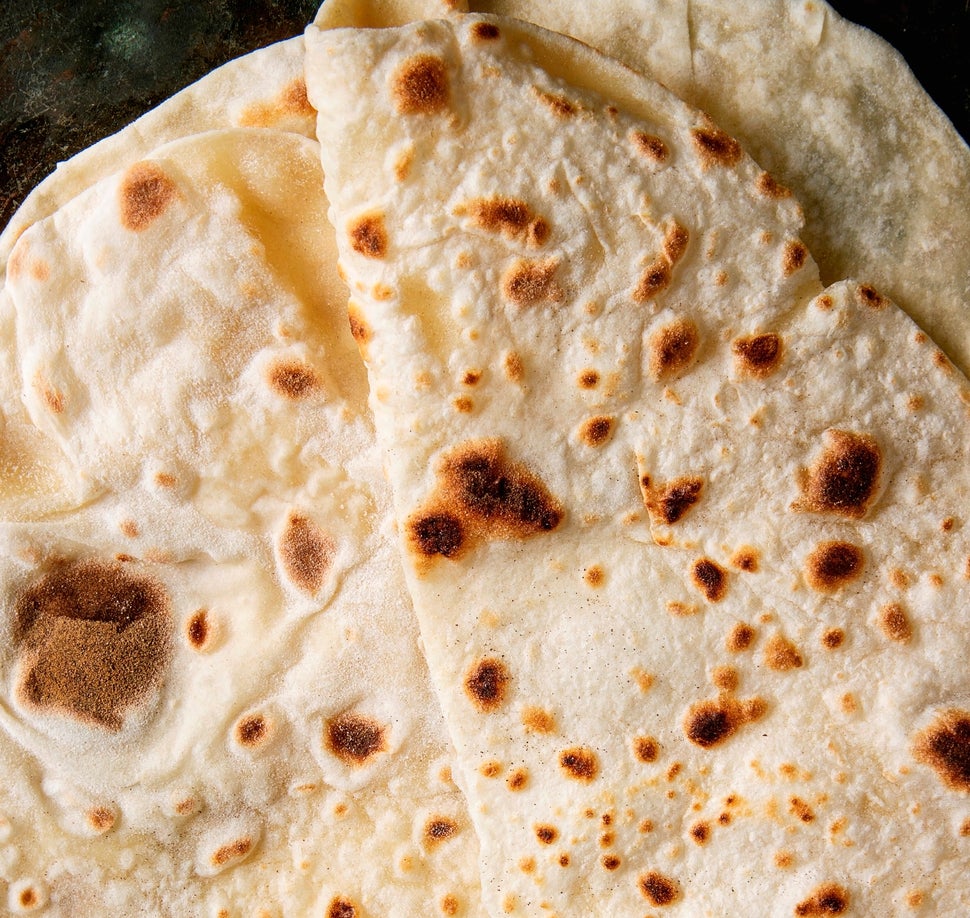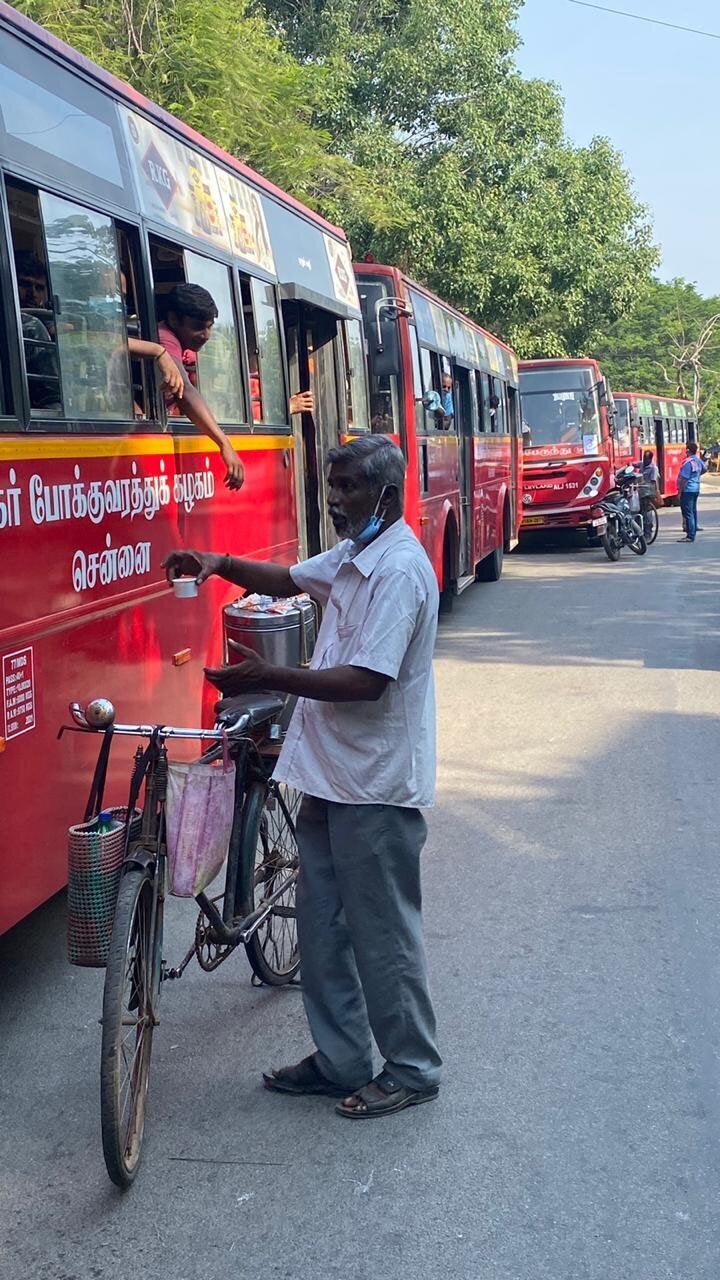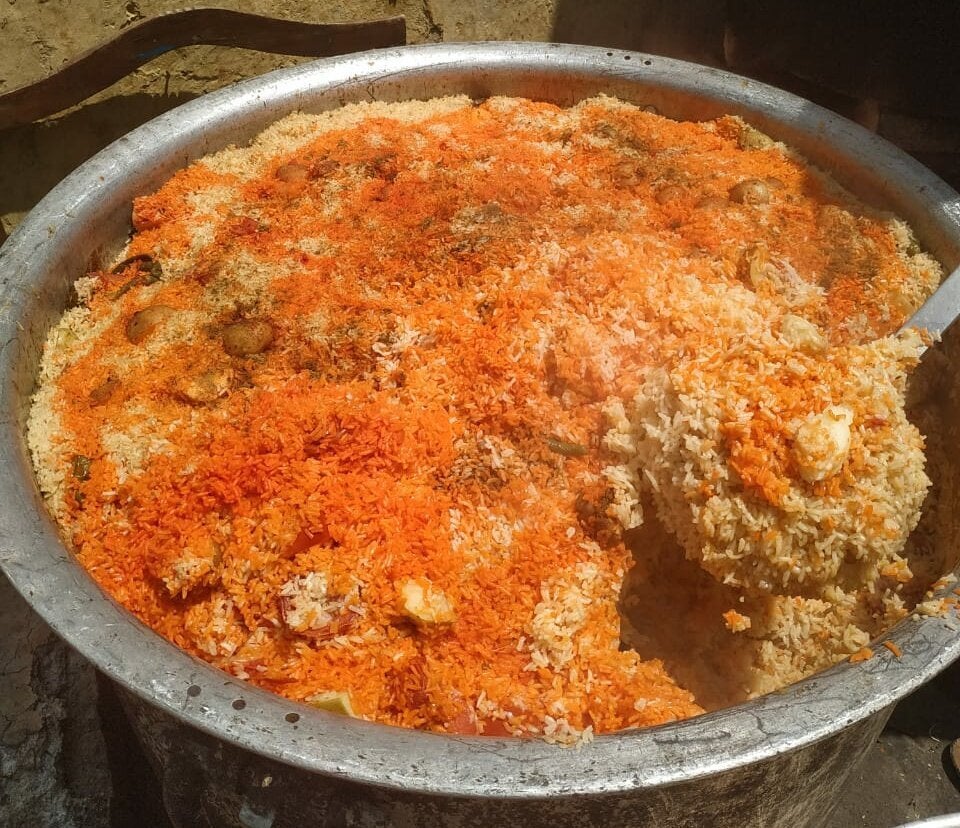
A few weeks ago, as I chased a particularly stubborn chunk of khejur gur with a knife while it slid around my chopping board in my Delhi home, I felt like I could hear my grandmother grumbling about how ‘Bangal mudi’, our local grocer in Calcutta, deserved a good yelling over the quality of jaggery he sold. I proceeded to do what I thought Sonama would, and tried to crush it with a mortar and pestle. But the jaggery wouldn’t yield, and a few crumbs clung to the aluminium pestle.
All I wanted to do that night was to sprinkle small chunks of gur into a bowl of hot milk and rice, watch them melt into little caramel swirls and then stir them till my rice was the colour of toffee. But that was not to be.
Frustrated, I chucked the jaggery into a pan of milk and boiled it till it melted, watching the milk bubble and turn a lacklustre ochre. Then I poured it on a bowl of rice and gulped down spoonfuls with the desperation I usually reserve for burrowing into a blanket on a particularly cold winter day.
It was, I think, Week 3 of the lockdown and the first time in around 20 years that I was having doodh bhaath for dinner. The last time I remember having milk, rice and jaggery mashed together, I was 15 years old, nodding off to sleep over an open chemistry book as my grandmother gently poked me with the warm steel bowl, asking if there was an equation that could solve why I always fell asleep as soon as I opened a text book.
A few days into the lockdown, as my anxiety tunneled through my sleep and began crawling all over my days, I began feeling less at home with myself. And at a time when home — the one where I have a childhood blanket stuffed inside a box bed and at least one room smells of my mother’s (and her mother’s) Pond’s talcum powder — seemed more distant and inaccessible than ever, food became a refuge for me.
Around this time, our social media timelines were blowing up with glossy photos of cooking accomplishments on one hand, and on the other, messages that asked people to be sensitive and not post about food when millions of migrant workers were stranded and starving. The gulf between how Indians with privilege and those without it accessed food was never more starkly visible than in the photographs that we scrolled past on Twitter and Instagram.
Lost in the back-and-forth was the fact that for many of us (with similar or more privileges than me), food was playing an important role in various ways—as an excuse to call an old friend or family member, as a way to connect to distant cousins on family WhatsApp groups, as a means to help the hungry or as a coping mechanism when the uncertainty got too much to bear.
As the lockdown stretched into weeks and then months, cooking the food I remembered from my childhood became some sort of a makeshift home I felt like hiding inside. Suddenly, the chaos of my childhood in a constantly conflicted, crowded Calcutta home became the order I pined for in my new, unfamiliar life. Thus came out the lukewarm doodh bhaath, and with it, a feeling of closeness to the people who always brought order into my life — my mother, and my late grandmother.
PRIDE AND SIMPLICITY
I only began cooking a few years ago, and my dishes mirrored the life I had built for myself. They did not reflect the comfort of home, but the excitement and distractions that came with moving away slightly later in life. My cooking was — like the quirky knick-knacks, moody lamps and flimsy curtains I stuffed my rented houses with — a marked departure from my mother’s and grandmother’s stern insistence on everything to be practical and thoughtfully budgeted. It was messy, fancy and exciting.
During the lockdown, however, I found myself constantly circling back to the food that I grew up on. My friend Debolina and I chatted about bhaathe — vegetables, often chucked into the pot with rice, then mashed up, sprinkled with chillies and a generous splash of mustard oil to go with rice. Vegetables I hated — pumpkin, kochu (colocasia), ole (yam) — often went down really well that way. My grandmother often tied a cotton potli full of moong dal and dropped it into a pot of boiling rice, and then mashed up the dal the same way as the vegetables.
Now when I look back, the frequency with which we ate bhaathe tells me a lot about my grandmother’s life — the lone elderly woman, looking after two children and cooking for six people, while my mother went to work. Bhaathe was nutritious, easy to cook and affordable, values that were often missing from my cooking.
One phone conversation with my mother ended up with her teasing me about how relieved I was that my flatmate Bohni could make perfect, soft, round rotis. Even in a family which often had a little less than enough, making me eat rotis was a battle that my grandmother and mother had to often fight — they tried maida rotis, they would bribe me with achaar, they would promise an Eclairs if I finished and then, they hit jackpot. If I ate my rotis every day without fuss, once a week, my grandmother would make ‘atta bhaja’ — whole wheat flour and sugar fried to make a sandy mass of fried sweetness.

My family was used to carefully rationing food and for us, atta bhaja became a distraction, often a warm reminder to us kids that a treat need not always be expensive. Within the bulwark of privileges I existed in — kids flashing their Toblerones and Ferrero Rochers at lunch — the women in my family had the thankless job of making me and my brother not feel out of place, school lunches being a confusing and obviously misleading signal of social class for a child. So, on some weekends when she had extra money, my mother would set to work with her egg whisk, vigorously beating butter, sugar and eggs to bake a fluffy vanilla cake. She would then cut it into neat pieces, and press Gems on top of the cake, to make it similar to the costly Flurys cakes that my classmates often brought in their lunchboxes.
Once, during an especially bad financial patch, we’d have just potato subzi for two weeks, for dinner, lunch and even for breakfast, with puffed rice or rotis. I’d shout and stomp my feet, claiming I’d ‘die’ if I had to have this one more day. No, I wouldn’t, my mother insisted and with a broad smile, said there’d be something special for lunch that day. It was potatoes, again. Only she had smeared it with masala, oil, and roasted the potatoes on the wire spatula used to make rotis. One day she thinly sliced onions, let them pickle in lime juice and then served them with a smattering of rock salt and black pepper. “Just like in hotels!” I remember squealing with delight, mostly stuffing my face with chapatis and pickled onions.
The food of my childhood was always a gentle nudge towards making peace with some discomforts.
So during the lockdown, I made plain vanilla cakes, on days I felt super lazy I chopped up potatoes and chucked whatever sauces or masalas came to my mind for dinners or lunches, I made a quick atta bhaja for snack, slightly dissatisfied that mine was more chewy than grainy than sandy, like in my memory.
My friend Debarati, who, unlike me, cooks average Bengali food every day, was locked down in her small, sunny apartment in Mumbai. And she craved data — drumsticks. The bigger, fatter drumsticks — stiff on the outside and slimy soft inside — used to be a staple in Bengali summer lunches, and kids were made to eat them on the unproven logic that chewing them would make our teeth stronger. Drumsticks — added texture to Bengali curries and chochchori (a dry vegetable mish-mash) — has a faintly sweetish taste. Normally, data has no place in the quick, in-between lunches that hold together our life. But during the lockdown, far away from her mother who lived alone in Kolkata, Debarati wanted to recreate the smells of her mother’s kitchen.
This craving for ‘home food’ was evident all over social media — the ‘trending videos’ were those of how to make fuchka (paani puri) at home, besan ladoo or, say, ‘home style’ chilli chicken. Sometimes, the recipes posted on Facebook or Instagram included elaborate notes on where the food came from, or the person’s memories around it.
And sometimes, the path to those memories is more complicated than a phone call or Google search.
SENSE AND INSENSITIVITY
When Anwesha Sarkar and Ria De of Dalit Camera arrived with rations at Nonadanga — a settlement of evicted slum dwellers in Kolkata — they met women, mostly domestic workers who had lost their jobs overnight, trying to feed their families. The video they uploaded on Dalit Camera’s Facebook page opens with the shot of a woman cooking masoor dal, part of the provisions that Sarkar and De had donated. Usha Halder, a domestic worker, dispassionately says that her cooking is ‘different’, with influences from the many places she had worked in and ate at, after she got married and moved to Kolkata with her husband at 14. She cooked for a living in people’s houses, and was let go without pay as soon as the lockdown began, she said.
Now, she said, there’s barely enough food for her family. A shot of her stirring the dal in a kadhai with a spatula is juxtaposed against an Instagram recipe videos of grilled sandwiches and fat chicken-stuff omelettes.

Very few men featured in the video. Sarkar and De told HuffPost India that while some of these families did not have any male presence — the men had left their families or had died — others had managed to find work as drivers or delivery people. In their absence, the responsibility of arranging food rested on the women.
When asked what they were cooking — a popular question for celebrities on social media and even during general conversations among the privileged — the women said there was barely enough ration to choose from. They walked to the nearby wilderness and looked for different kinds of wild saag, which they then cleaned and cooked. “It’s something we do every day,” the women seemed to echo each other.
The video attempted to begin a conversation on the politics of food on social media and served as yet another example on how the lockdown was outright cruel for the less privileged.
“Consumption for the affluent classes has continued during the lockdown in spite of the lack of mobility, and consumption at at least two levels; of food (of course diy, because since you can’t buy, you reproduce), and of images of food. And a third kind of consumption would be of the people (largely celebrities etc) who are putting out these self-promotional videos. This was to draw a contrast with how the poor are figuring out food and how they are part of the production of food for the affluent classes,” Sarkar and De said in an email interview to HuffPost India.
The video also sought to engage with the history of the women’s food, their aspirations around food and their skills, something that is grossly overlooked though they are an integral part of producing and preparing food for the privileged, dominant classes.

“The point about these videos is to show that food for the poor is not just a matter of subsistence, which is how it has been represented generally. Policies on food reflect that as well. And this has intensified further during the lockdown. Food is connected to aspirations, to knowledge, to one’s identity and awareness about their own social location, to health, to skills,” the reporters of Dalit Camera told HuffPost India.
That food can be as precious and sentimental to the poor as it is to the privileged is not given the attention it deserves, as evident from the quality of food served by the government to migrants stuck in various cities. A tweet from a few weeks ago showed an aluminium container filled to the brim with rice, with barely a spoonful of chhole it in. Apparently, this was the food served one day by the Delhi government to migrants stranded without work and food.
Srini Swaminathan, who has been organising, food, refreshments, water and toys for migrant workers and their children who are taking trains back to their home states from Chennai, said he had often heard people complain about the ungratefulness of “these people” when some packaged food was found discarded in stations.
Srini, whose relief packages comprise a mix of practical and thoughtful — he began by packing sweet milk bread with jam, ghee chapatis with pickle, Glucon D packets, and now organises biscuits, spiced puffed rice, chivda, milk bottles for babies, snacks for the children — said that governments often did not recognise the journey back home as an emotional one. But as aid workers, it was important to recognise the emotional connect people have towards food, and not have the ‘handouts’ remind them about how miserable their plight is.
Srini said he ate the food he distributed regularly, often trying out the chapatis a day or two later for dinner to see if they were still soft and edible — they were — because a lot of these journeys would last for days, with the travellers not having enough money to buy food on the road.
“The workers often spoke about how they were afraid that the food they were carrying won’t last them the whole journey, so they only discussed the practicality of it with strangers,” he said.
He’s also constantly observing and learning. One day, he noticed an elderly tea seller walking past the migrant workers sitting in a queue in front of the station. A few of them spoke to the man and enquired about the price. When they realised it was Rs 10 a cup for ginger tea, they quietly went back without ordering tea. It was odd, he thought, very few people refuse tea in our country.

When Srini offered to buy them tea, their faces lit up, and they all lined up. It was a lightbulb moment for him. In the donation posts he put up, he later asked if anyone wanted to donate ‘adrak chai’ for the workers, realising that the things our privileged eyes often gloss over can be deep and personal for someone else. Something as small like a cup of tea can mean a lot of the emotional well-being of a person, something the privileged classes which run governments often refuse to recognise.
Sneha Sharma, a professor at Ramjas College, got together with a group of friends to cook for at least 100-200 people who were left without work in her neighbourhood in north Delhi. It was a challenging task—the food had to be nutritious and filling, as well as something they could cook in bulk in their small vessels and kitchen stoves.
“We were very conscious that their tastes might differ. For instance, they might have liked rotis because they take more time to digest, but they require a lot more cooking time, resources, and skill, and is nearly impossible if you only have 2-3 hours of cooking time. Not everyone in the group was comfortable making rotis so we made pooris instead and replaced them with kulchas later,” Sharma said.
To make sure people with varying tastes could make a meal out of their food, they always added chutneys, salads and later, dates and bananas, in case some of them could not eat the food they had cooked.
Sharma’s group cooked everything from chhole kulche and paneer bhurji, to different kinds of rice dishes — khichdi, curd rice, pulao — like they would in their own homes. “We once made bread pakoda and vada pav. The volunteers who distributed the food said it was a huge hit,” Sharma recalled.
REASSESSING WHAT FOOD MEANS
Faheem Muqeem, a 35-year-old biryani seller in Nizamuddin, Delhi, got into the business because he did not know any better. Hailing from a long line of cooks, it was almost foretold that he’d become a cook too. He first worked at a few eateries as a youngster, and when he had enough money, opened a biryani kiosk he has been running for a few years now.
“This was never a question. I knew I had to cook, because everyone in my family did. I never thought of whether I loved cooking, or if I had interest in food. I knew I had to, and do it well if I intended to make a living out of it,” Muqeem told HuffPost India.
But the lockdown changed that and gave him a chance to reassess his relationship with food, perhaps for the first time in his life. “The two-three days I lay in bed doing nothing, after my shop closed down, felt like two months of doing nothing,” Muqeem said, emphasising that he felt he was nothing if he did not cook. Soon, he was put in charge of a relief effort where he cooked, with a team of four young newbies, for 800 stranded, poor people in Nizamuddin. “Cooking was always work for me, but I now realised it is a gift god has given me, something that helped me and so many people at the time of need.”

For Eid, Muqeem cooked sheer korma and biryani for the community kitchen and his wife cooked the same back home for their family. “It’s food that makes you happy,” he said.
For Pradeep Kumar, who ran a chapati shop in Chennai before the lockdown hit business, food has become a rallying point when life gets difficult. He and his wife set up the shop after their mobile phone recharge and accessories shop had to be shut down.
“We are Rajasthanis. Perfecting a chapati is a huge deal for us. It has to be soft, have a little whiff of ghee and you can eat it with just a tiny smear of pickle. We did not know that the business would take off so well. Within a couple of months, we had queues in front of our shop for chapati,” Kumar said.
The lockdown, however, changed all that. The shop shut down, and the little savings Kumar had was running out.
“I had hired four workers who were from UP. I told them, I can feed them three meals a day, but after a few days I would have no money to pay their salaries,” he said. Three of them left, one stayed back and moved into Kumar’s house because he couldn’t pay his rent.
“It was depressing, but it was also a reminder of how Indian food often uses the simplest things and makes the tastiest treats. Food kept us together when we were down and desperate,” Kumar recollects.
One evening they quickly kneaded some dough, mashed potatoes, mixed it with masala and made samosas for the family to lighten their mood. There were just 5-6 samosas, one for each, but it was reassuring.
One night, instead of using the little paneer they had for dinner, they mashed it up to make gulab jamun, and had that with roti instead. “Of course, we made simple puris now and then when things got very glum. It immediately made us happy, did not need fancy, expensive ingredients and took our mind off our worries,” Kumar said.
When Swaminathan began pooling money for his relief work, he roped in Kumar to make chapatis for the migrants.
“I could feel what they were going through. I left no stone unturned to make sure they had a good meal,” he said.
Kumar also taught some other food stall owners nearby how to make his chapatis, as the demand for them grew in course of the relief operations. “They will also earn some, we will all survive,” he told HuffPost India. Food, Kumar said, was life in more ways than he had realised before.
(With inputs from Ismat Ara)